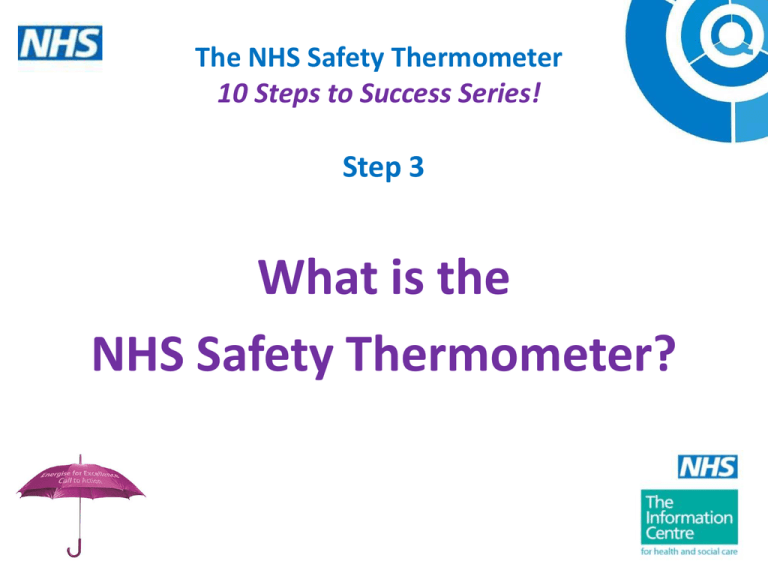
The NHS Safety Thermometer
10 Steps to Success Series!
Step 3
What is the
NHS Safety Thermometer?
Journey so far: Nurse Sensitive Indicators,
NHS Safety Thermometer & E4E
Nurse sensitive
indicators
2009
Inclusion in NHS
Operating
Framework
2012-14
Pressure Ulcers
Falls
Catheters & urine
VTE
NHS ST
For Safety Express
Linking in with E4E
& QIPP safe care
2010
Pilot Monthly data
collection Sept
2010
Design Principles
1. The instrument must be patient focussed and measure
harm free care (the absence of all four harms) as well as the
individual harms.
2. The instrument must be clinically valid with pragmatic, clear
operational definitions for each harm.
3. The instrument must be efficient; not take longer than 10
minutes per patient (preferably shorter) and fit within the
daily work flow of frontline clinicians.
4. The instrument must be equitable and capable of being
used wherever the patient is located (home, community or
hospital setting)
5. The instrument must give a timely summary of results
which can be used for teams in their improvement work
6. The data collected using the instrument must be easy to
aggregate to show results at ward, organisation, region and
national level.
Construct and Development in 2011
Agree Operational
Definitions
Develop &
test a
measurement
instrument for
harm free care
from pressure
ulcers, falls,
catheters and
VTE by
September
2011
Develop Technical Capability
• Evidence review
• Expert debate / input
• Grey areas agreed
• Practical use
• Design characteristics
• Local, regional, national
• Universal platform
• Guidelines for use
Determine how the
instrument is used
• Who collects & when?
• From where?
• What happens after?
• How are data used?
Determine the level of user
satisfaction
• Local users - feedback
• Data leads - feedback
• Leadership
• Senior stakeholders
Falls
Point Estimate
Pressure
Ulcers
100% of appropriate patients
surveyed on ONE day per month
Catheters
& Urine
Infection
Harm
Free
Care
VTE
Prevalence & Incidence
The NHS Safety Thermometer
measuring ‘harmfreecare’ at the point of care
Measures patients that are
‘harm free’ at the point of
care in a systematic way
Asks questions about four
key outcomes:
Pressure ulcers
Falls
Urinary infection
VTE
Integrates measurement into
daily routines
Supports improvements in
patient care and patient
experience
Prompts immediate actions
by healthcare staff
Allows us to measure in any
A call to action for frontline healthcare professionals Salford
setting where care is being
Royal NHS Foundation Trust are one of 170 organisations that are
delivered
currently using the NHS Safety Thermometer once per month to
Available to all from
rapidly review the proportion of patients free from harm
www.ic.nhs.uk
www.harmfreecare.org
Features of the NHS ST
Standard
Operational
Definitions
Focussed on
high volume
harm
Complete in
less than 10
mins per
patient
Use in all
care settings
National
Regional
Local
Local data
collection
by frontline
teams
Auto
Analysis &
Graph
Data Merge
/
Aggregation
What are the
Primary Outcome
Measures?
How can we look at the data?
For each measure we can look at the proportion of patients or the
number of patients
Pressure Ulcers
Age
Sex
Location
Specialty
Category
II-IV
New
(Incidence)
Harm from Falls in a care
setting (in the last 72
Age
Sex
Location
Specialty
Harm from
falls
Low harm death
Treatment of Urine
Infection (in patients
with urinary catheter)
Age
Sex
Location
Specialty
New and
old UTI
Length of
time in situ
Treatment of new VTE
Age
Sex
Location
Specialty
New VTE
PE, DVT or
other
Harm Free Care
(absence of above)
Age
Sex
Location
Specialty
All harms
No harms
Old
All
(Prevalence)
hours)
What are the Secondary
Measures?
New
Harms
For each measure we can look at the proportion or the number of patients
Falls
Age
Sex
Location
Specialty
Within 72
hours
Urinary Catheters
Age
Sex
Location
Specialty
Length of
time in situ
VTE Risk Assessment
Age
Sex
Location
Specialty
Yes, no, n/a
VTE Prophylaxis
Age
Sex
Location
Specialty
Yes, no, n/a
Treatment of VTE
Age
Sex
Location
Specialty
Old and
New VTE
No harm Death
PE, DVT or
other
Absence of harm from
Pressure
ulcers
Falls
Urinary
infections
(in patients with
catheters)
Harmfreecare
VTE








